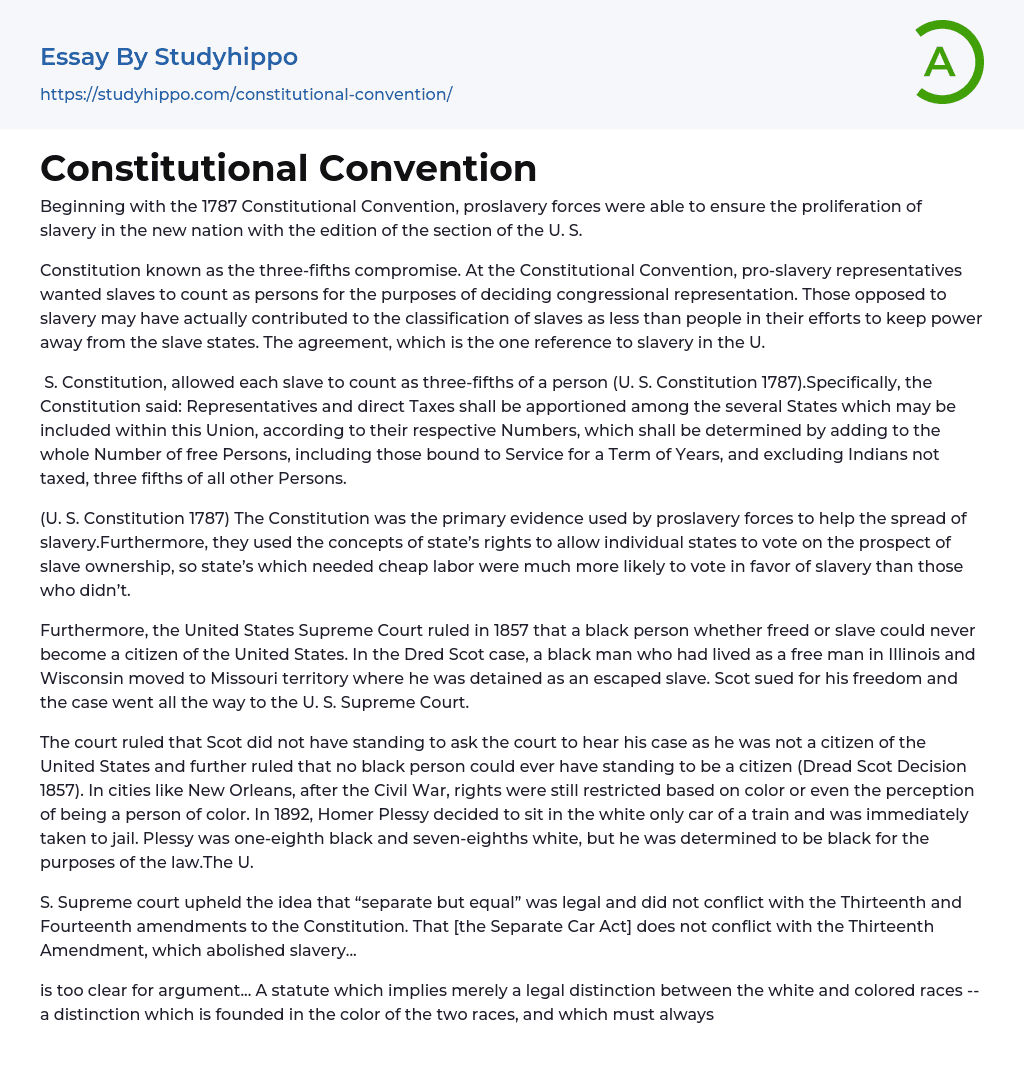Proponents of slavery successfully increased its presence in the United States by adding corresponding sections to American documents, beginning with the Constitutional Convention of 1787.
During the Constitutional Convention, there was a debate over how to count slaves for determining congressional representation. Pro-slavery representatives wanted slaves to be counted as full persons while those against slavery may have helped classify slaves as less than people to prevent the slave states from gaining too much power. This compromise, known as the three-fifths compromise, is the only reference to slavery in the U.S. Constitution.
The U.S. Constitution stated that each slave would be considered three-fifths of a person in 1787. The Constitution specified that when apportioning representatives and direct taxes among states in the Union, the number of free individuals plus three-fifths of all other persons, in
...cluding those in service for a limited term, but excluding untaxed Indians, would determine the respective numbers of each state.
(U. S. Constitution 1787) Supporters of slavery utilized the Constitution as their main means to promote its growth, taking advantage of state sovereignty to permit individual states to decide on allowing or prohibiting slave ownership. This led those who required cheap labor to be more supportive of slavery than those who did not.
The U.S. Supreme Court's 1857 decision in the Dred Scott case declared that individuals of black ethnicity could not be recognized as citizens of the United States, regardless of their enslavement status. This ruling was made following Dred Scott's legal pursuit for freedom, having been held as a runaway slave in Missouri territory despite formerly living freely in Illinois and Wisconsin. Ultimately, the dispute over his citizenship reached the highest cour
in the country.
The Dread Scot Decision, issued in 1857, established that due to his non-American citizenship, Scot was ineligible to present his case in court. Furthermore, the ruling implied that black individuals were incapable of attaining citizenship. Following the Civil War, urban areas such as New Orleans persisted in discriminating against people of color and those perceived as such. In response, Homer Plessy intentionally sat in the train car reserved for white individuals in 1892 and subsequently faced arrest. Despite being primarily of white descent, Plessy's classification under law was "black."
The U.S. Supreme Court considered the legality of the concept "separate but equal" and determined it was consistent with both the Thirteenth and Fourteenth amendments to the Constitution. Specifically, the court found that the Separate Car Act did not violate the Thirteenth Amendment's prohibition of slavery.
The legal equality of both races cannot be undermined by a law that solely distinguishes between white and colored races based on color. This distinction will persist as long as color continues to differentiate white people from other races.
The Fourteenth Amendment sought to ensure equal treatment for both races within the law; however, it did not aim to eradicate social inequality or distinctions based on color. Consequently, Plessy v. Ferguson established separate but unequal facilities that persisted until Brown v. Board of Education of Topeka, KS challenged them in the 1950s. Although these amendments granted citizenship to former slaves, they failed to fully safeguard their rights. In fact, even though the Civil Rights Act of 1875 prohibited some types of discrimination, it was not enforced and instead led former slave states to devise new methods of keeping black
men as second-class citizens and preventing them from voting.
Some of the preferred methods for achieving this were the implementation of poll taxes, grandfather clauses, and literacy laws. During the period prior to the conclusion of the Civil War, educating black individuals was prohibited by law, making it easy to pass a decree which stated that individuals who could not read or write would be denied the right to vote. This technique for suppressing the voting rights of former slaves became obsolete when a significant number of freed slaves expressed a fervent desire to learn and quickly became literate. This situation was compounded further due to poor white men also experiencing difficulties with literacy.
With the unavailability of racial tests, Southern states resorted to using poll taxes and grandfather clauses to screen out voters. However, the poll tax had the same issue as literacy tests as it excluded poor whites too whereas grandfather clauses were particularly successful in barring freed slaves from voting. The laws proclaimed that individuals whose grandfathers were ineligible to vote would also be ineligible, thus eradicating the possibility of immigrants and Blacks voting in these regions.
Many laws remained enforced for several years, and some continued to affect voting in the Southern states until 1964 when the Civil Rights Act was enacted. While composing his "Letter from a Birmingham Jail," Martin Luther King Jr. highlighted that these laws still impacted voting in the South. In fact, certain counties in Alabama had no registered black voters despite having a black majority population as of 1963. In his letter, King implored religious leaders to reject immoral and unfair laws and stand up for what
is just.
- First Amendment essays
- Jurisprudence essays
- Social Injustice essays
- Juvenile Justice essays
- Agreement essays
- Business Law essays
- Common Law essays
- Community Policing essays
- Constitution essays
- Consumer Protection essays
- Contract essays
- Contract Law essays
- Copyright Infringement essays
- Court essays
- Crime essays
- Criminal Law essays
- Employment Law essays
- Family Law essays
- Injustice essays
- Judge essays
- Jury essays
- Justice essays
- Lawsuit essays
- Lawyer essays
- Marijuana Legalization essays
- Ownership essays
- Police essays
- Property essays
- Protection essays
- Security essays
- Tort Law essays
- Treaty essays
- United States Constitution essays
- War on Drugs essays
- Armed Forces essays
- Confederate States Of America essays
- Federal government essays
- Federal Government Of The United States essays
- Fourteenth Amendment To The United States Constitution essays
- Governance essays
- Jurisdiction essays
- Parliament essays
- Politics essays




